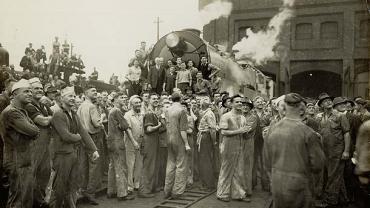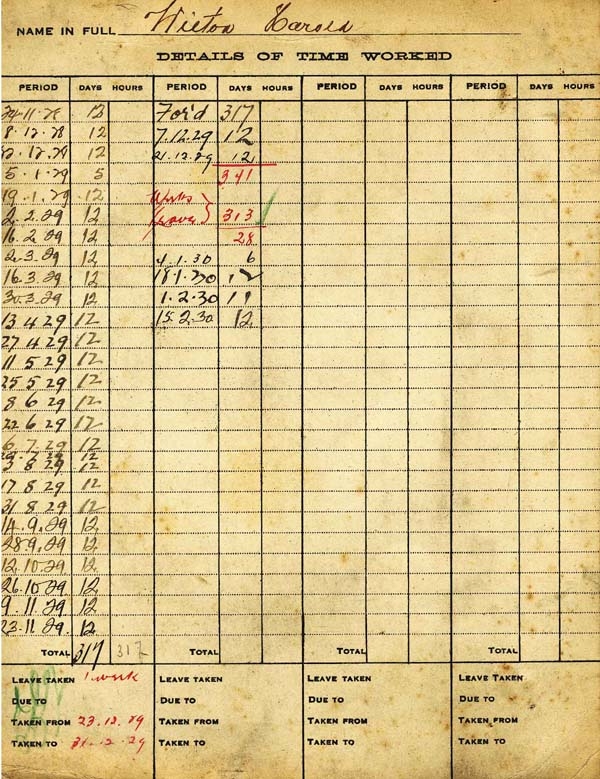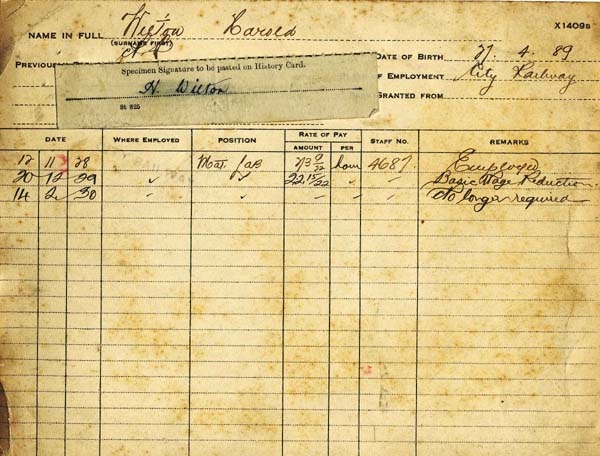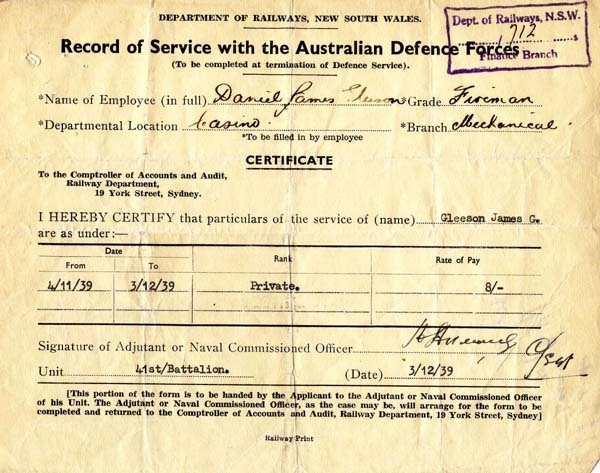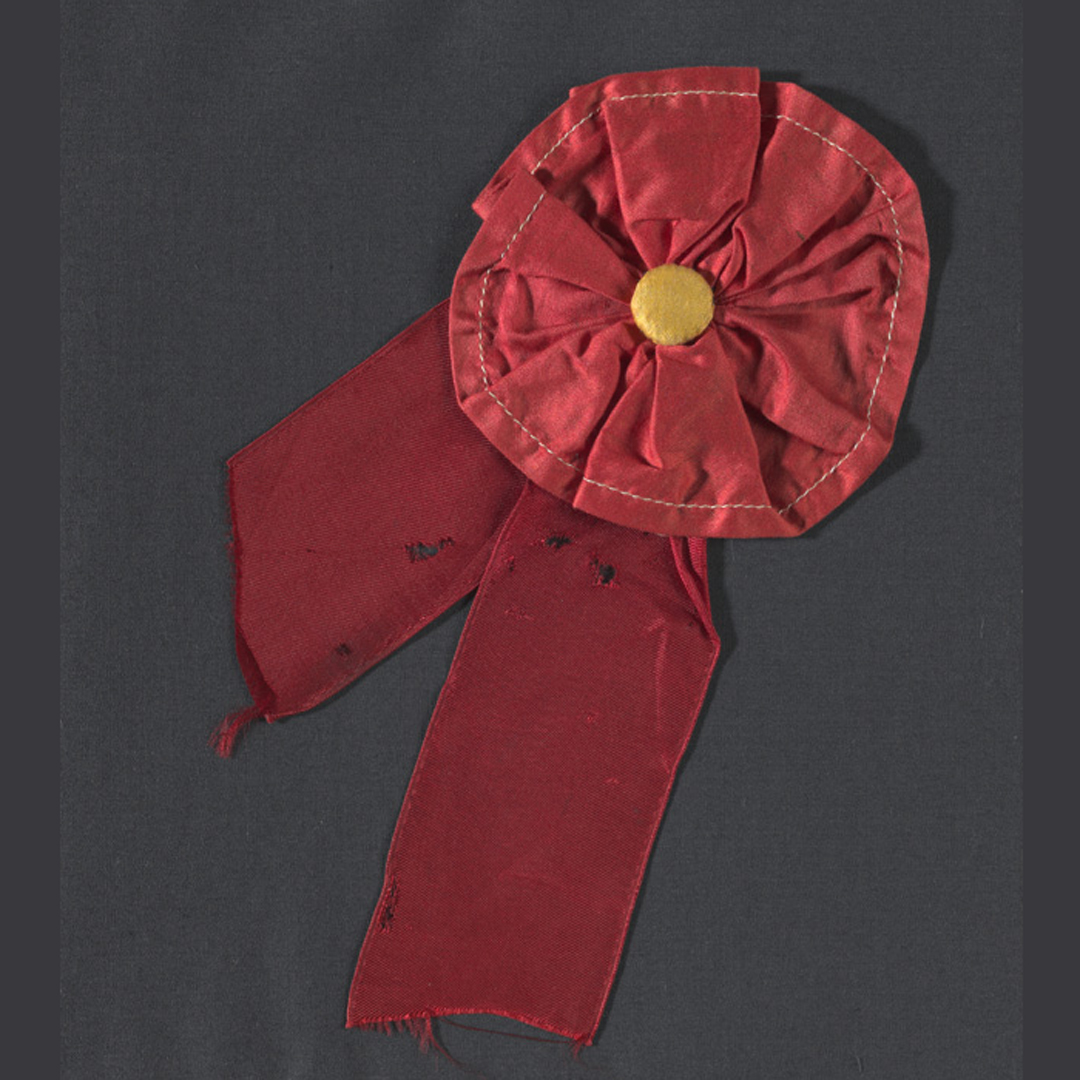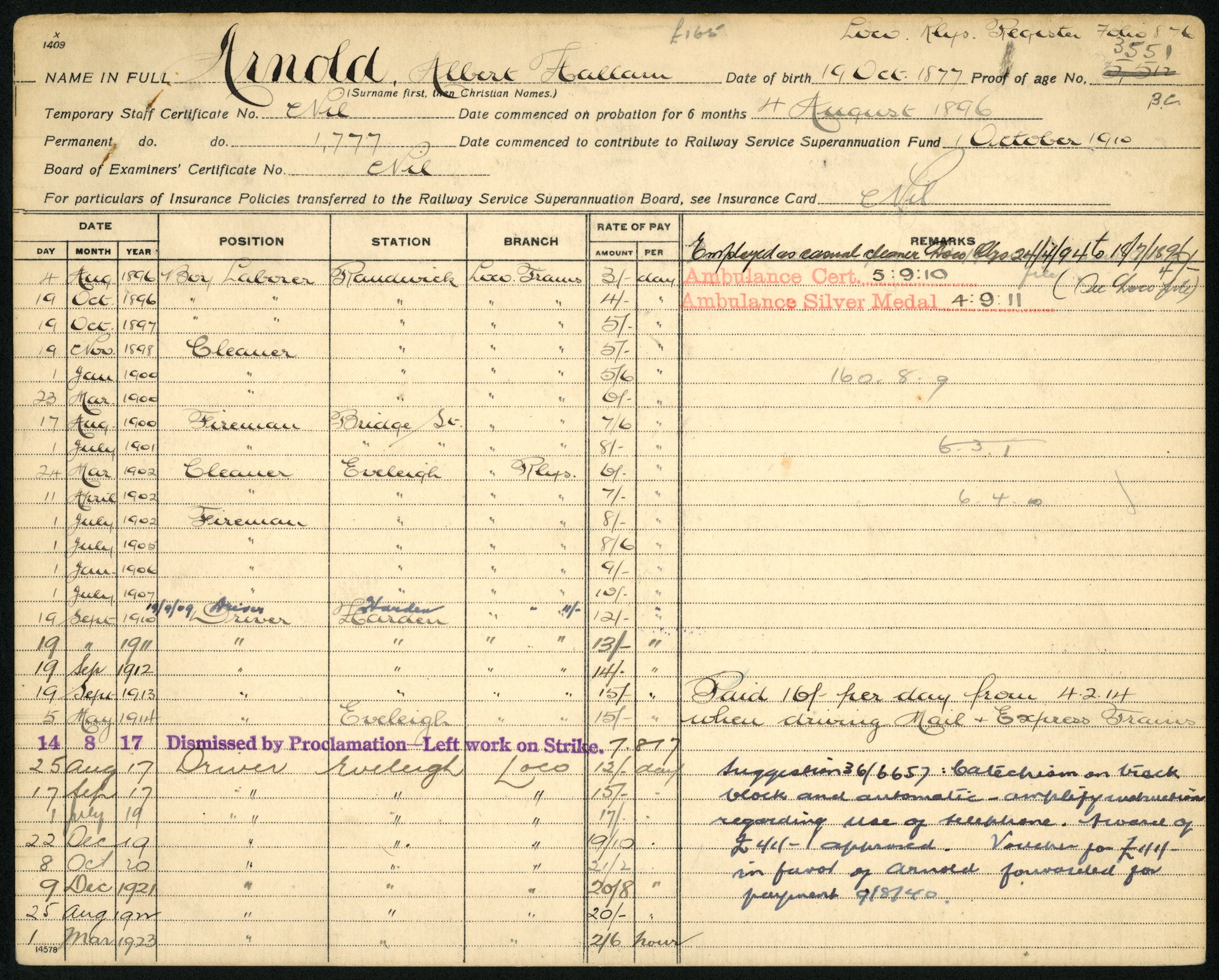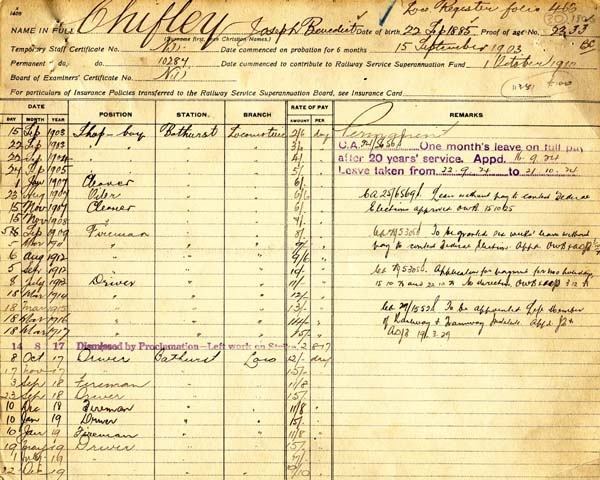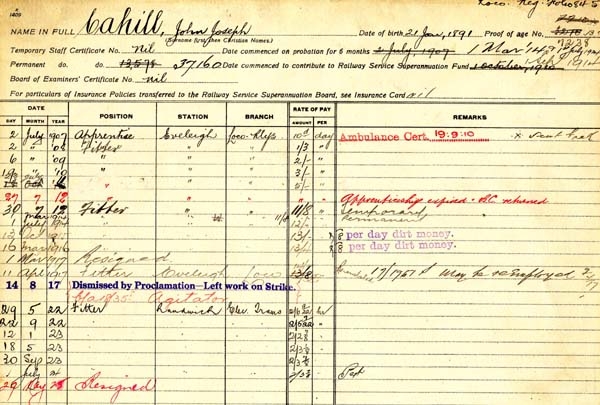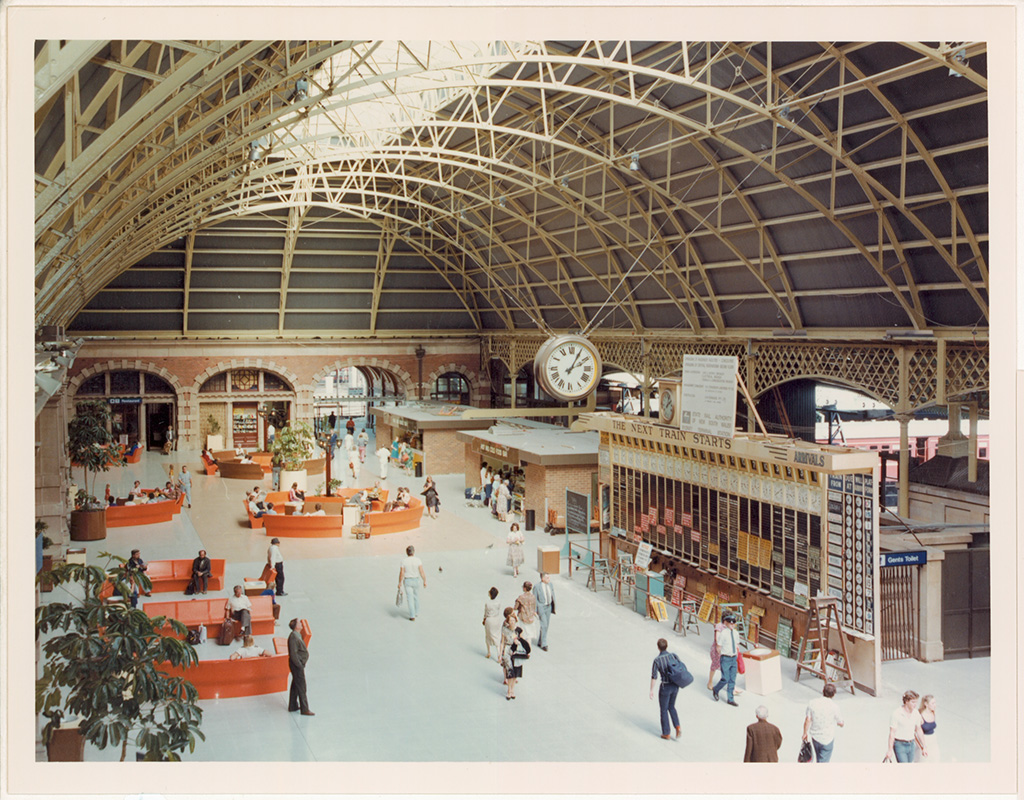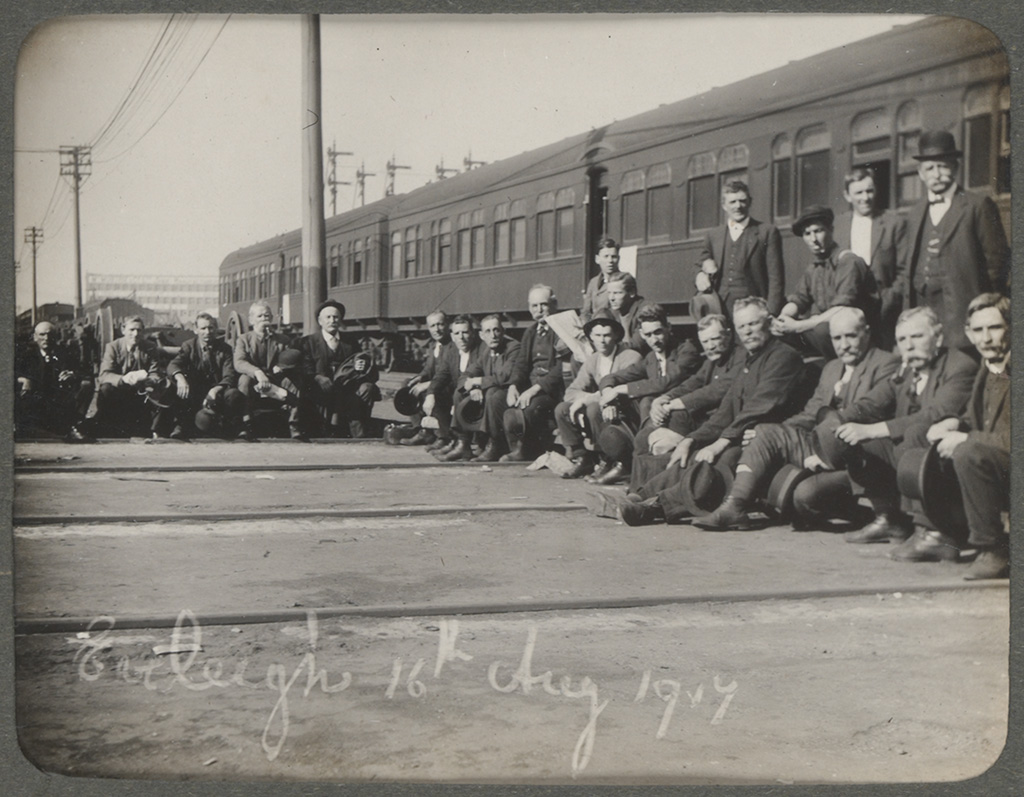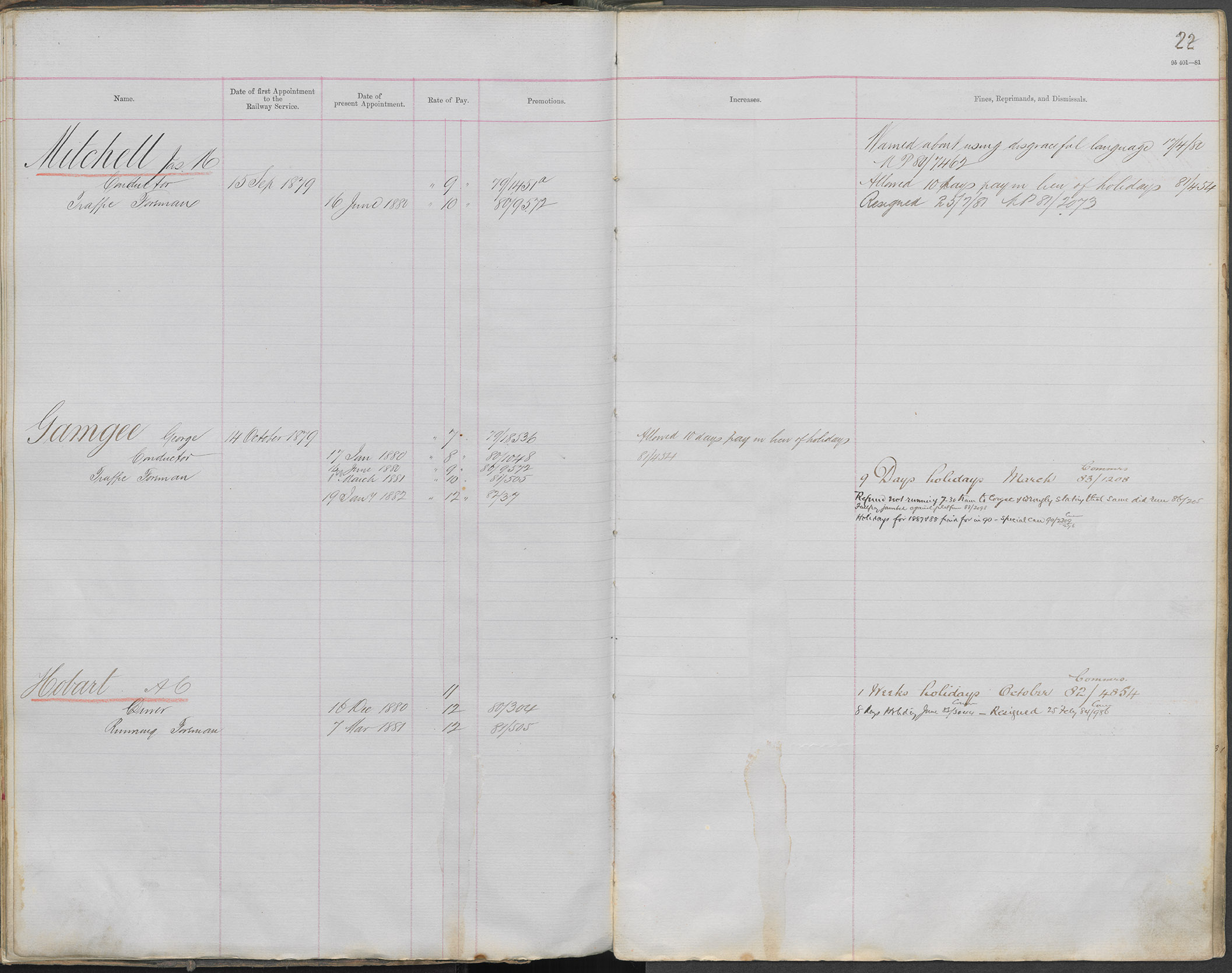Employment with the Railways covered a large range of positions, including working as a driver, cleaner, engineer, draftsman, inspector, timekeeper, porter, ganger etc.
Overview
Railway service provision commenced on 26 September 1855 when the first trains operated on the Sydney-Parramatta or the 'Great Trunk' line. In its first full year of operation over 350,000 passengers had used the service. Passenger traffic continued to be the largest single purpose for train journeys in the nineteenth century and accounted for more than half of all train miles traversed. By 1871 of a total of 931, 333 miles travelled 537, 846 miles were by passenger trains. In 1880 the Commissioner for railways observed that the number of passengers had risen from 776,707 to 5,440,138 in a decade during which time the miles of railway line had increased from 339 to 849 miles.[1]
Thousands of people were needed in order for the trains to run on time. Employment with the Railways covered a large range of positions, including working as a driver, cleaner, engineer, draftsman, inspector, timekeeper, porter, ganger etc.
Did your ancestor work on the Railways?
Establishing if your ancestor was employed by the railways is the first step to researching the records.
- A death certificate may indicate whether your ancestor worked for the railways
- There may be family stories handed down through generations, or from surviving relatives who knew that a member of the family was working on the railways.
Access to railway employee records
Many of the records listed in this Guide are Closed to Public Access for 30 years.
The employee history cards are Open to Public Access after 30 years from the date of separation (the date the employee left the organisation)
For permission to access closed records contact:
Transport for NSWInformation and Privacy Office
Email: information@transport.nsw.gov.au
Tel: (02) 8202 3768
List of main record series
Please note some of the record series are still identified by the original State Rail 'R' number. This number will be replaced by a NRS (New South Wales Record Series) number in due course.
| Series | Title | Dates |
|---|---|---|
| NRS 19333 |
Personal History Cards - Employees born between 1900 and 1962 These cards record appointment and service history details of railway employees born after 1900. The cards were kept by the Finance Branch for superannuation purposes and include employees from a range of metropolitan and country locations. If you are unable to visit the Western Sydney reading room you can order a copy from this series of the Personal History Cards via the Copy Service page. |
Employees born 1900-1962 |
| NRS 19375 |
Personal history cards - country and metropolitan employees These cards cover people primarily from country regions and workshops. Noted dates of birth range from 1898 to 1967 and almost all entries on the cards, with a few exceptions, are prior to the end of 1986. |
1928-1986 Employees born 1898-1967 |
| NRS 12922 |
Personal History Cards - Employees born before 1900 The cards show details relating to an individual's employment e.g. name, date of birth, educational qualifications and details of service. If you are unable to visit the Western Sydney reading room you can order a copy from this series of the Personal History Cards via the Copy Service page. |
Employees born pre-1900 |
| NRS 19407 |
Register of salaried officers Lists employment details of salaried officers working for the NSW Government Railways and Tramways during the period 1856-1890, including name, office, date of appointment, authority, remarks and a 'Remarks' column which notes salary changes, promotions, resignations, retirements, and acting position. |
1856-1890 |
|
Nominal Roll of the First Railway Section, Australian Imperial Expeditionary Forces (AIF) This volume provides details of railway employees who formed the 1st Railway Section of the Australian Imperial Expeditionary Force, including name, rank, age, marital status, trade or calling, address at date of enrolment, next of kin and address, religion, date of joining, unit for those already serving in the military, per-diem paid before and after embarkation, daily rate of deferred pay, name and address of allottee and remarks. Included is a group photograph of the 1st Railway Section taken at the Sydney Show Ground prior to departure for France. |
5 Feb 1917-29 Jan 1920 | |
| NRS 15895 |
Personnel Register - Darling Harbour This volume details the employment history of workers at Darling Harbour Goods Yard. Information recorded includes employee's name, date of birth, position, station and salary. Industrial relations issues relating to the strike of August 1917 and subsequent employment of temporary staff are also documented. The records of employees who did not participate in the Railway Strike of 1917 have their entries stamped '6/8/1917. - Remained loyal. All prior offences expunged.' |
24 Apr 1909-7 Jul 1932 |
This is a list of railway employment records that have been kept by various departments within State Rail over many years. Once you are sure your family member worked on the railways these records may help you to fill in the details of their employment.
| Series | Title | Dates |
|---|---|---|
| R319 |
Signals & Communications Branch |
c. 1920-1990 |
| R320 |
Trading & Catering Service |
c. 1920-1990 |
| NRS 19509 | Personal History Cards, Stores Branch | c.1920-1990 |
| NRS 19510 |
Personal History Cards, Traffic Branch |
c.1900-c.1990 |
| NRS 19512 | Personal history cards for employees of the Division Engineer's branch, Newcastle | 1900-1999 |
| NRS 17370 | Personal History Cards from Area Operations Manager, Junee | c.1913-1993 |
| NRS 19514 | Personal History Cards, Traffic Branch | c.1926-1988 |
| NRS 17419 | Personal History Cards from District Superintendent, Lithgow | c.1915-c.1989 |
| NRS 19516 | Personal History Cards, Support Services | c.1935-c.1988 |
| NRS 19518 | Personal History Cards, Division Engineer, Wagga Wagga | c.1927-c.1989 |
| R361 | Programme Engineer Branch - Prince Alfred Siding, Prior | 1940-1985 |
| NRS 19519 | Personal History Cards, District Superintendent, Newcastle | c.1930-c.1990 |
| NRS 19520 | Personal History Cards, Tamworth Division | c.1940-c.1980 |
| NRS 19521 | Personal History Cards, Mechanical Branch | 1920-c.1988 |
| NRS 19522 | Personal History Cards, Mechanical Branch, Eveleigh Workshops | c.1920-c.1988 |
| NRS 16445 | Personal History Cards, Way & Works Administration | 1921-1988 |
| NRS 16447 | Personal History Cards, Electric Car Workshops Chullora (Elcar) | 1926-1991 |
| NRS 16448 | Personal History Cards, Orange District Traffic Branch | 1912-1986 |
Related records
The records listed here are not as popular or extensively used as some of the other examples listed above. Many of these records only cover a limited time period.
| Series | Title | Dates |
|---|---|---|
| NRS 12923 |
Time and pay sheets for railway employees on the Western line These five sheets contain a description of work performed, days worked, name, occupation, and wages earned by each employee. |
1-15 Jun 1882 |
| NRS 15936 |
Personnel Files of Staff Engaged in Military Service - Locomotive Depot, Casino Personnel files of staff employed by the Locomotive Depot, Casino while engaged in military service during the Second World War. Above: "Mechanical Branch, Part of a file for Daniel J. Gleeson, a Fireman from Casino, dealing with his service with the Australian Defence Forces during World War 2. Over 7000 NSW railways and tramways workers enlisted for active service (Gunn, p.284)." |
14 Sep 1939-16 Apr 1949 |
| NRS 12921 |
Register of electrical engineers employees - extra staff Register detailing name, date of birth, duties, station, rate of pay, engagement (date, reference to authority, date of expiry), date of first entry into the service, details re extension of engagement and how dealt with. |
1891-1908 |
| NRS 19530 | Revised roll of Ambulance Corps members [NSW Railways and Tramways Ambulance Corps] | 1886-1923 |
| R502 |
Staff Register - Traffic Branch Bound volume detailing name, date and details of appointment, promotion or resignation and salary. Details of disciplinary action and the date are also recorded. |
1876-1882 |
| NRS 19556 |
Register of Deaths, Railway Services Superannuation Board Registers of deaths of retired employees. They list various employee details, including date of birth, proof of death, address of employee at time of death, next of kin. Female officers were included from 1968. |
1910-1985 |
| R352 |
Retirement Entitlements, Payments and Pensions records, Railway Services Superannuation Board Records relating to the eligibility of payments / pensions for retired officers under various sections of the Railway Superannuation Services Act 1910 and the Government Railways Act 1912. Included are unclaimed pension books, information on refunds and the eligibility for widows of deceased male officers. Female officers are included in later registers. |
1910-1990 |
| NRS 16411 |
Land and Property Valuation Files This series contains files relating to the valuation of railway land, property and residences. They include applications by employees (and their position in the railways) to purchase land, build or extend residences and requests for financial assistance. |
1942-1980 |
NSW Government Gazettes
Lists of Railway employees were published every 3 years in the Government Gazettes from 1891-1939. We hold copies of printed lists up to 1909 in our Reading Room. You can also search the Government Gazettes online on the Trove website using the term “New south wales government railways and tramways list of persons employed”.
The General Strike of 1917
The General Strike or the Great Strike of 1917 lasted for six weeks from 2 August until the 8 September. It started in the Randwick Workshops and Eveleigh Carriage Shops over the introduction of a card system to record what each worker was doing and how fast the job was being completed. The workers were not allowed to view or modify the card and the monitoring system could be used to identify 'slow workers'. The strike quickly spread from the railways in New South Wales to other industries such as coal mines, wharfes, factories and warehouses and into other States until about 100,000 workers were on Strike.[1]
A skeleton railways was kept operating with the help of 'Loyal' workers and voluntary help from the public. The photos on this page are images of those loyalists who continued to do their jobs over the six weeks of the Strike. It provides a snapshot of what life was like in what looks like grim times.
On August 14 1917 the Government dismissed the striking rail and tramways workers for misconduct. On the personal history cards that can be viewed on this page this act is referred to as "Dismissed by Proclamation. Left work on Strike." After the Strike ended many of these workers were rehired but about 2000 workers were refused re-engagement.[2] Many strikers found themselves in subordinate positions while Loyalists were given seniority and some strikers lost their accumulated superannuation.[3] There was a long-lasting feeling of bitterness and hatred in the railways. The railwaymen had to wait until 1925 for the Labor Premier, John T. Lang, to restore seniority and lost rights to the striking workers.
References
[1] John Gunn, Along Parallel Lines: A history of the railways of New South Wales 1850-1986, Melbourne University Press, 1989, p.286.
[2] Ibid, p.288.
[3] Ibid.


